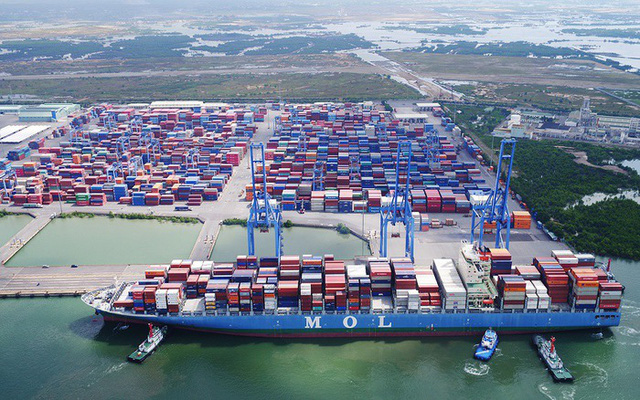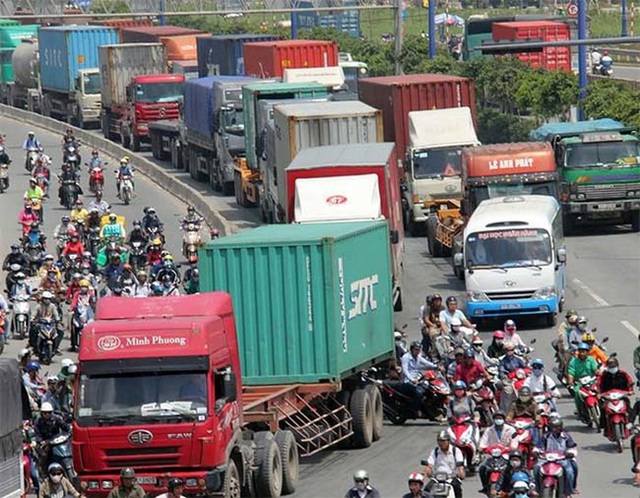Solving the “problem” of deep-water ports to develop the marine economy in the Southeast
The Southeast is known as an important dynamic economic region of the country, an economic “gateway” and a bridge connecting Vietnam to the world. The provinces of the Southeast region have made great contributions to the total value of industrial production, export turnover and the budget. However, in the past time, the development of the region has not been commensurate with its potential and advantages.
It’s still the story of connecting infrastructure
A recent report by the People’s Committee of Ba Ria – Vung Tau province said that due to the complicated situation of the COVID-19 epidemic in 2021, a number of key local economic sectors have suffered many negative impacts from the pandemic. epidemics, production value and revenue all decreased, but the revenue of seaports still increased by 22.4. Total throughput of goods through Cai Mep-Thi Vai port in the year was 79 million tons, up 4%, of which container goods by sea increased by 16.8%.
Chairman of the People’s Committee of Ba Ria – Vung Tau province Nguyen Van Tho said that Cai Mep – Thi Vai port cluster is the international transshipment port cluster with the highest frequency directly going to Europe and North America and is one of 23 ports in the world. The world can receive ships with a tonnage of up to 250,000 tons, belonging to the group of 50 seaports with the highest container exploitation output in the world, annually contributing to the central budget more than 20,000 billion VND in import and export taxes.
Mr. Tho said that the current Cai Mep – Thi Vai port system is not qualified to become an international transshipment port, has not attracted large shipping lines and has lost its competitiveness with other deep-water ports in the region. region and the world.
Ports are being divided, wharfs are not connected, goods from small ships to large ships are not connected, not really transshipment ports; lack of a specialized inspection organization on site; lack of a specialized inspection agency. logistics ecosystem; lack of a multimodal inter-regional transport system; high logistics costs, long clearance time” – Mr. Tho said.
Being assessed as having great potential and advantages of a river system with navigation functions (inland waterways, maritime) but Ho Chi Minh City is facing many barriers, gradually losing the advantages of many industries. is currently a spearhead as logistics, trade associated with ports.
Specifically, Cat Lai and Tan Thuan ports are overloaded and cause congestion for inner city traffic. Although the Soai Rap tributary ports are continuing to invest in expanding their scale, they are quickly being deposited. The Cai Mep – Thi Vai port system on the Long Tau river has excess capacity but lacks traffic connections and logistics services, the ability to transship rivers, railways, and roads to serve industrial parks/zones. produce…
At the same time, the city’s transport system is not synchronized, leading to longer travel distances, more frequent congestion, increased pollution and costs. Meanwhile, in the neighboring secondary cities, the manufacturing industries grew stronger, leading to stronger growth in services for industrial, commercial and logistics enterprises.
The deep-water port and logistics centers distributing import and export goods have moved to Ba Ria – Vung Tau and Dong Nai, causing the economic sectors associated with the port in the central urban area of Ho Chi Minh City to gradually decline and become an important destination. force in the development of the city’s marine economy.

Tan Cang – Cai Mep International Port
“Solving math” to open the door to developing marine economy in the Southeast
According to the Ministry of Transport, the Southeast region currently handles more than 60% of container cargo volume and 45% of total cargo volume through Vietnam’s seaport system. In the next few years, the region will develop strongly and attract the most active investment in the field of transport infrastructure. On the other hand, with the position of the largest airport in the country in the future and the largest deep-water seaport cluster in the country today, Long Thanh airport and Cai Mep – Thi Vai seaport cluster have all the necessary factors. to become hubs for the development of the aviation and port industries.
Many experts believe that the potential of these two centers is best brought into play when a complete connected transport system is built. However, in fact, National Highway 51 is the only current connecting traffic route between Long Thanh airport and Cai Mep – Thi Vai port cluster which is overloaded. Therefore, Ba Ria – Vung Tau and Dong Nai provinces need to quickly invest in the construction of the Bien Hoa – Vung Tau expressway and the Bien Hoa – Cai Mep railway section to solve traffic needs, especially when Long Thanh airport project phase 1 completed construction and put into operation.
“Connecting the Southeast’s transport infrastructure is extremely important in the context of the recovery of the world economy, and Vietnam’s exports have reached over 200% of GDP. The ministry showed signs of slowing down when the transport infrastructure was not synchronized to keep up with economic growth and export goods.
Infrastructure connection is a problem that needs to be solved quickly, firstly connecting the road to Cai Mep port and dredging the channel, exploiting the full capacity of this port to be on par with major ports in the world. – Assoc. Dr. Tran Hoang Ngan, Director of the Ho Chi Minh City Institute of Development Studies, discussed.
Mr. Ngan said that the development of the railway system; dredging the river, ensuring the depth for large ships… this investment will recover very quickly because the region has a rapid growth momentum with centers such as Ho Chi Minh City, Dong Nai, Binh Duong, Ba Ria – Vung Tau.

Traffic jam on the route to Cat Lai port
Sharing the same comment with Mr. Ngan, Dr. Nguyen Ngoc Hieu – Viet Duc University said that investing in seaport infrastructure, including wharf infrastructure and navigational channels, is the right direction and needs to be done. of Ho Chi Minh City. Besides, it is necessary to develop a road system connecting with economic corridors and belts; renovate and upgrade inland waterway channels, ports and wharves in accordance with planning, creating favorable conditions for transportation activities on inland waterways.
Mr. Nguyen Xuan Thanh (Fulbright University Vietnam) proposed and resolutely removed the spread investment in seaport development. Resources must be focused on investing in the international gateway port system. If the local economy wants to develop, it must connect with these port systems to support multi-modal transport, not just ports.
The system of international gateway ports in the North and Southeast has been identified, so priority should be given to the construction of transport infrastructure connecting highways, railways and rivers from economic regions, including: the whole central coastal area to come here. Prioritize the development of logistics services in two directions: a logistics center associated with industrial parks and a logistics center in the gateway port area.
In terms of policy, anti-investment is spread out, but it does not mean that it absolutely prohibits the creativity of localities or businesses in proposing new investments. But this proposal must be financed by private capital, not by direct state resources or indirect support and subsidies.
Besides, one of the needs of seaports to be solved is the competition in shipping prices, which is being relaxed. Some ports put shipping costs below cost, making deep-water ports uncompetitive. Because the investment for this port is very expensive, so the transportation cost is quite high.
Meanwhile, looking at some countries in Asia, they always have port authorities. That is, there is a government agency that sets shipping rates in accordance with the actual conditions of each seaport to ensure fair competition for ports.
* Invite readers to watch programs broadcast by Vietnam Television on TV Online and VTVGo!
at Blogtuan.info – Source: vtv.vn – Read the original article here



